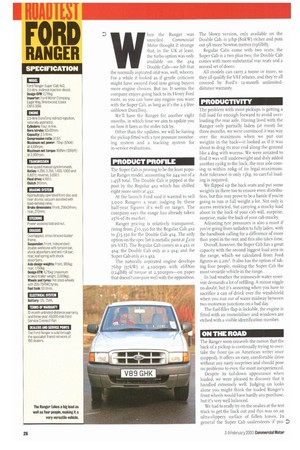PRODUCT PROFILE
Page 28

If you've noticed an error in this article please click here to report it so we can fix it.
The Super Cab is proving to be the least popular Ranger model, accounting for 244 out of a 1,458 total. The Double Cab is pipped at the post by the Regular 4x2 which has shifted eight more units at 432.
At the launch Ford said it wanted to sell 3.cioo Rangers a year; judging by these half-year figures it's well on target. The company says the range has already taken 25% of its market.
Ranger pricing is relatively transparent, rising from Lto,35o for the Regular Cab 4 X2 to L15,35o for the Double Cab 4x4. The only option on the spec list is metallic paint at L2I0 (ex-VAT). The Regular Cab comes as a 02 or 4x4: the Double Cab only as a 4x4; and the Super Cab only as a 4x2.
The naturally aspirated engine develops 76hp (57kW) at 4,100rpm with 168Nm (i24Ibft) of torque at 2,500rpm—on paper that doesn't compare well with the opposition. The blown version, only available on the Double Cab, is 3 thp (8okW) richer and puts out 98 more Newton metres (n961bft).
Regular Cabs come with two seats; the Super Cab is a two plus two; the Double Cab conies with more substantial rear seats and a second set of doors.
All models can carry a tonne or more, so they all qualify for VAT rebates, and they're all covered by Ford's 12-month unlimiteddistance warranty.




































































































